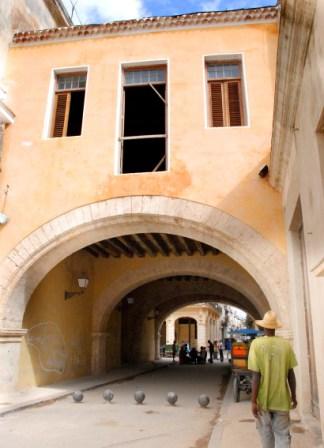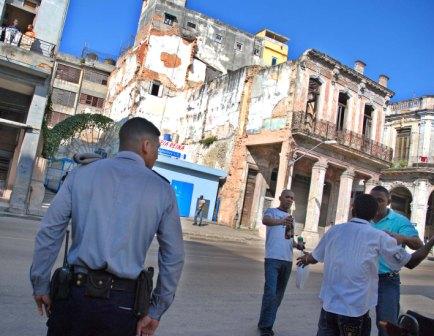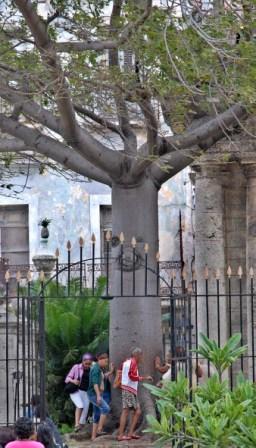Multiplying Old Havana’s Experience
By LUCIA LOPEZ COLL, photos by CARIDAD
HAVANA TIMES, February 22 (IPS) – Even though I am not attracted by secret spells and mysterious liturgies, I accompanied a dear friend of mine last November 16 to the traditional ceremony that commemorates the foundation of the Township of San Cristobal de La Habana.

We had planned on carrying out the ritual of asking for three wishes while we went around three times the ceiba tree that, according to historians, marks the place where the first mass and the new city’s town council meeting were held. However, when we got to the Plaza de Armas we discovered an immense line of persons who had the same intentions and we preferred to take advantage of the more than propitious occasion to stroll through the oldest part of the city, which was celebrating its 489th anniversary.
And it was the best thing that could happen to us. We toured those old and narrow streets for almost an hour, marveled over how much has been done to rescue the old buildings, the old mansions as well as the most humble homes that coexisted wall to wall and that today have been revived for the pride and enjoyment of their residents and visitors. We also admired the clean and tastefully illuminated streets, with beautiful gardens planted with trees and sculptures, like an unusual haven on the margin of the chaotic, dirty and increasingly more deteriorated city.
I should say that throughout that tour we regretted not having some type of guidebook that would reveal to us the secrets of the buildings: the original owners of that beautiful mansion, the history of that impressive building of modernist architecture turned into the Raquel Hotel, or details of that Plaza Vieja that, thanks to the work carried out, seems new. And although I suppose that type of book must exist for tourists, it should also be at the disposal of Cubans interested in that information.
In any case, be they converted into hostels, commercial establishments, museums and restaurants, or still conserving their features of private homes, Old Havana’s buildings are being rescued from neglect, mistreatment and shortages, by government decision and, above all, thanks to the invaluable work by the Office of the Historian led by Eusebio Leal, which has been able to commit hundreds of persons in the effort, despite it being a road full of obstacles.

But the miracle of the restoration has not just been possible through the force of goodwill and knowledge. I have serious doubts that such a large enterprise could have been carried out if it wasn’t for the Master Plan for the Integral Revitalization of Old Havana, which began being applied in 1994 and was capable of bringing together all the forces in a joint plan of action.
Neither could so much progress have been made without the application of a law (No. 143) which grants the Office of the City Historian some autonomy to manage certain companies in its territory, and invest part of that income in many of the restoration works that we admire today.
Havana Costs, But It’s Worth It
Unfortunately, the stroll through the old walled-in city came to an end and as we withdrew from its perimeter and we entered Centro Habana the urban landscape radically changed. It was as if the time machine that had transported us to the colonial past had returned us, due to an inexplicable mistake, to a present devastated by some disaster.
Here the rundown buildings coexist with others in a better state, although it was difficult to differentiate them because of a lack of paint, their dirty facades and the improvised solutions in the buildings that have justly been called the “ruralization” of the city.

The comparison was inevitable and we began speculating about the possibility of putting into practice the restoration work in Centro Habana, and the rest of the capital. Why not a project similar to the one being carried out in Old Havana?
We agreed that it would be impossible to reproduce the same plan given the differences of each part of the city, since all the urban areas do not have the same architectural values or the same tourist interest.
However, far from being an obstacle, this circumstance potentially encloses new possibilities, since while work is being done to preserve a valuable patrimony where it exists, replacing the most deteriorated buildings with other more modern and functional ones can not be postponed without distorting the city’s most authentic features.
The idea is to apply experiences already tried out in the Historical Center, like the facilities granted to the City Historian’s Office, to reassess other areas of the city. Meanwhile, this could provide one of the possible responses to the housing deficit in the country.
Mario Coyula Cowley, Emeritus Professor and 2001 National Architecture Prize winner, has said more than once that “Havana costs, but it is worth it.” He says “what’s important is the principle of an intelligent self-management that integrates the economic with the cultural and the social. The idea is to enable the majority of the city to pay for itself.”
Many specialists and institutions are aware of the serious decaying infrastructure problem faced by the city. Since its creation, the Group for the Integral Development of the Capital (GDIC), which has made important contributions in the field of urbanism and strategic planning, has worked to channel those concerns. However much remains to be done, states a report presented by the City, Culture and Architecture Commission of the Union of Writers and Artists of Cuba (UNEAC) at the end of last year.

“We should think on how to conserve existing assets as well as on how to produce a quality architecture and urbanism that improves the habitat and thus leads to raising the feeling of identity and belonging of our people,” stated the Commission.
It further suggests, “A priority urban and architectural policy in the national development programs” in order to face “a series of aspects that threaten the development and balance of the urban areas.” These include “the physical and human aging of the cities” and the “lack of maintenance and generalized housing deficit.”
The UNEAC commission also notes the “lack of connection between the city’s urban planning and development strategy as well as a financing deficit,” to carry out approved projects. Furthermore, it states that the “plans are not sufficiently taken into account by decision-makers.” A lack of urban control and generalized disrespect for urban planning regulations, by the private as well as the state sector were other extremely important aspects of the report.
In its conclusions, the Commission recommends strong support to carry forward the development projects, and suggests that the financing can come from diverse complementary sources, such as the central government, local participation (already proven in Old Havana), and international resources. It notes that foreign capital should only be permitted when it doesn’t lead to “abandoning the principles of social justice and sovereignty that should prevail.”
When dealing with the most urgent problems that the capital presents today (many of which are surely repeated in other cities in the country) and pointing out possible solutions, the assessment made by UNEAC becomes a valuable document.
Let’s hope that those ideas reach receptive ears and can have an influence in future construction plans in response to the housing needs and the urgent rehabilitation demanded by the city, in which the locals should play a fundamental role, like the model applied in Old Havana. And that is one of my wishes for this year, even though I didn’t go round the mythical ceiba tree three times.





